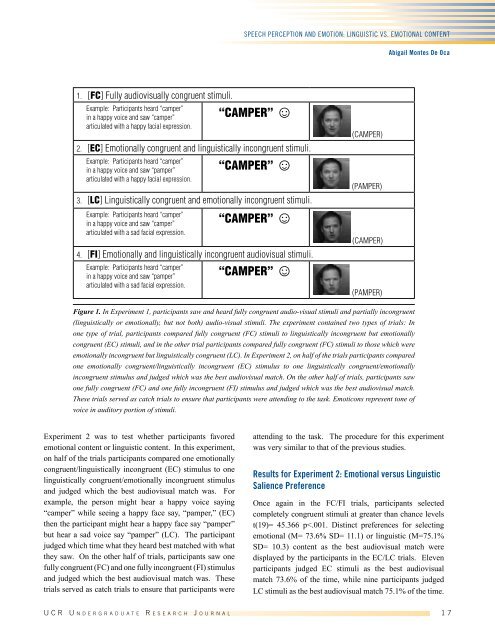Undergraduate Research Journal
Undergraduate Research Journal
Undergraduate Research Journal
You also want an ePaper? Increase the reach of your titles
YUMPU automatically turns print PDFs into web optimized ePapers that Google loves.
Speech Perception and Emotion: Linguistic vs. Emotional Content<br />
Abigail Montes De Oca<br />
1. [FC] Fully audiovisually congruent stimuli.<br />
Example: Participants heard “camper”<br />
in a happy voice and saw “camper”<br />
articulated with a happy facial expression.<br />
“CAMPER” ☺<br />
2. [EC] Emotionally congruent and linguistically incongruent stimuli.<br />
Example: Participants heard “camper”<br />
in a happy voice and saw “pamper”<br />
articulated with a happy facial expression.<br />
“CAMPER” ☺<br />
3. [LC] Linguistically congruent and emotionally incongruent stimuli.<br />
Example: Participants heard “camper”<br />
in a happy voice and saw “camper”<br />
articulated with a sad facial expression.<br />
“CAMPER” ☺<br />
4. [FI] Emotionally and linguistically incongruent audiovisual stimuli.<br />
Example: Participants heard “camper”<br />
in a happy voice and saw “pamper”<br />
articulated with a sad facial expression.<br />
“CAMPER” ☺<br />
(CAMPER)<br />
(PAMPER)<br />
(CAMPER)<br />
(PAMPER)<br />
Figure 1. In Experiment 1, participants saw and heard fully congruent audio-visual stimuli and partially incongruent<br />
(linguistically or emotionally, but not both) audio-visual stimuli. The experiment contained two types of trials: In<br />
one type of trial, participants compared fully congruent (FC) stimuli to linguistically incongruent but emotionally<br />
congruent (EC) stimuli, and in the other trial participants compared fully congruent (FC) stimuli to those which were<br />
emotionally incongruent but linguistically congruent (LC). In Experiment 2, on half of the trials participants compared<br />
one emotionally congruent/linguistically incongruent (EC) stimulus to one linguistically congruent/emotionally<br />
incongruent stimulus and judged which was the best audiovisual match. On the other half of trials, participants saw<br />
one fully congruent (FC) and one fully incongruent (FI) stimulus and judged which was the best audiovisual match.<br />
These trials served as catch trials to ensure that participants were attending to the task. Emoticons represent tone of<br />
voice in auditory portion of stimuli.<br />
Experiment 2 was to test whether participants favored<br />
emotional content or linguistic content. In this experiment,<br />
on half of the trials participants compared one emotionally<br />
congruent/linguistically incongruent (EC) stimulus to one<br />
linguistically congruent/emotionally incongruent stimulus<br />
and judged which the best audiovisual match was. For<br />
example, the person might hear a happy voice saying<br />
“camper” while seeing a happy face say, “pamper,” (EC)<br />
then the participant might hear a happy face say “pamper”<br />
but hear a sad voice say “pamper” (LC). The participant<br />
judged which time what they heard best matched with what<br />
they saw. On the other half of trials, participants saw one<br />
fully congruent (FC) and one fully incongruent (FI) stimulus<br />
and judged which the best audiovisual match was. These<br />
trials served as catch trials to ensure that participants were<br />
attending to the task. The procedure for this experiment<br />
was very similar to that of the previous studies.<br />
Results for Experiment 2: Emotional versus Linguistic<br />
Salience Preference<br />
Once again in the FC/FI trials, participants selected<br />
completely congruent stimuli at greater than chance levels<br />
t(19)= 45.366 p














